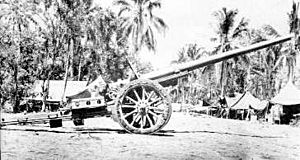Type 92 105 mm cannon facts for kids
Quick facts for kids Type 92 105 mm cannon |
|
|---|---|

Type 92 105 mm cannon
|
|
| Type | Field gun |
| Place of origin | |
| Service history | |
| In service | 1932-1945 |
| Used by | |
| Wars | Second Sino-Japanese War Soviet-Japanese Border Wars World War II |
| Production history | |
| Designer | Osaka Arsenal |
| Manufacturer | Osaka Arsenal |
| Produced | 1932-? |
| No. built | 180 |
| Specifications | |
| Mass | 3,732.3 kilograms (8,228 lb) |
| Barrel length | 4.681 metres (15 ft 4 in) L/45 |
|
|
|
| Shell | 15.77 kilograms (34 lb 12 oz) |
| Caliber | 105 mm (4.13 in) |
| Recoil | hydropneumatic |
| Carriage | split trail |
| Elevation | -5° to +45° |
| Traverse | 36° |
| Rate of fire | 6-8 rpm |
| Muzzle velocity | 760 m/s (2,493 ft/s) |
| Maximum firing range | 18,300 metres (20,000 yd) |
| Sights | panoramic |
The Type 92 105 mm cannon was a powerful weapon used by the Imperial Japanese Army during World War II. It was also known as a "10-cm" gun. This large artillery piece helped in battles during the Second Sino-Japanese War and World War II. It was designed to replace an older cannon, the Type 14 105 mm cannon, on the battlefield.
Contents
How the Type 92 Cannon Was Made
The first version of the Type 92 cannon was finished in 1932. Not many of these cannons were built, fewer than 200 in total.
Where the Type 92 Cannon Was Used
This cannon was first used in a battle called the Battle of Nomonhan. This happened in 1939.
Later, in 1942, the Type 92 cannon was used during the Bataan and Corregidor Island in the Philippines.
On the island of Guadalcanal, American soldiers, specifically the US Marines, gave these guns a nickname: "Pistol Petes."
Related Weapons
Images for kids





